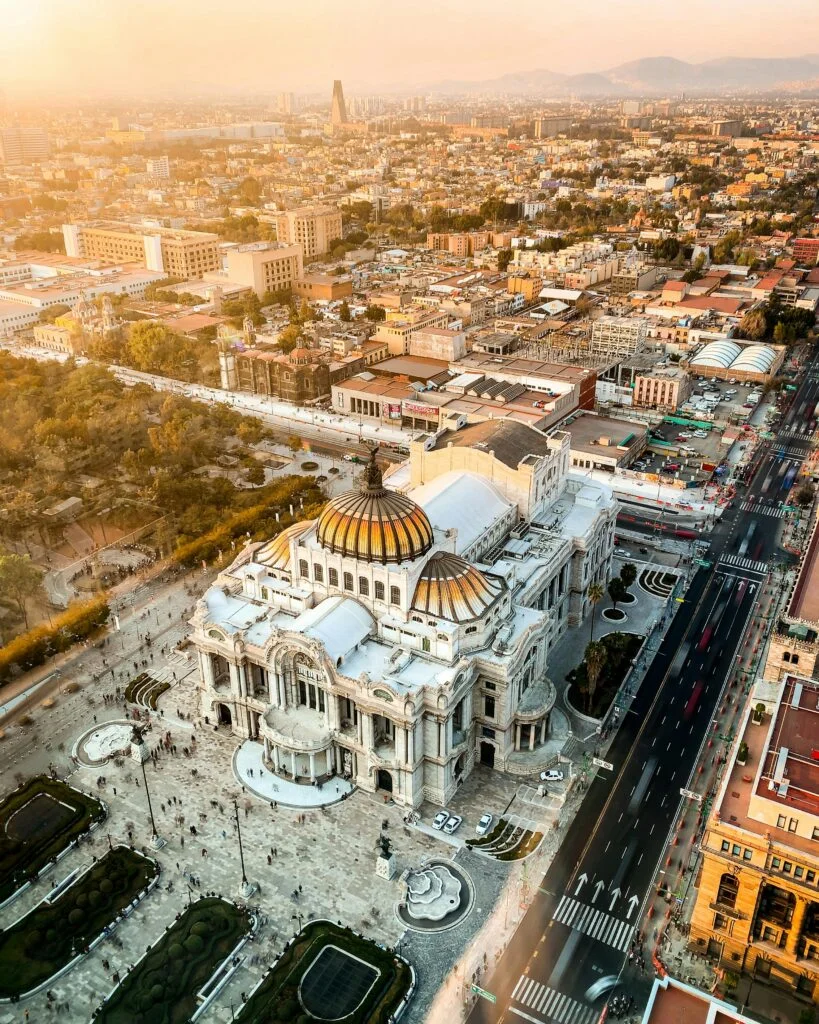Planning a trip to Mexico but unsure when to go? Finding the best time to visit Mexico depends on what you’re looking for—whether it’s perfect beach weather, cultural festivals, or budget-friendly travel. This comprehensive guide breaks down Mexico’s seasons, regional climate variations, and special events to help you plan the perfect Mexican adventure in 2025.
Mexico’s diverse geography creates distinct climate patterns across the country, from the sun-drenched beaches of the Yucatán Peninsula to the cooler highlands of Mexico City. Planning a trip that fits your tastes and travel style requires an understanding of these trends.
The most beautiful thing in the world is, of course, the world itself.
Wallace Stevens
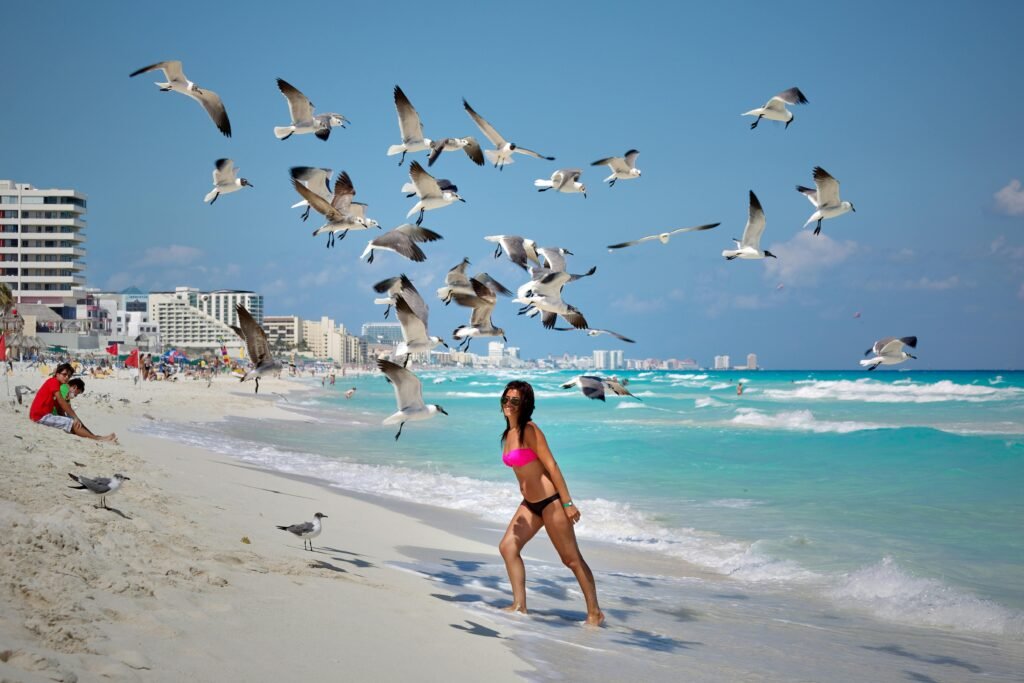
Image: Sunny beach in Cancun during dry season
Mexico experiences two primary seasons that significantly impact your travel experience. Knowing the characteristics of each helps you choose the ideal time for your visit.
I. Mexico Dry Season (Dec–Apr): Perfect Weather, Peak Vibes
Thinking of heading to Mexico? The dry season—from December to April—is hands-down the best time to go. Blue skies, sunshine, and barely a drop of rain make it ideal for everything from beach bumming to jungle exploring. But fair warning: you’re not the only one with this idea.
Why This Is The Season to Travel
Here’s what makes this window so magical:
- Temperatures: A sweet 22–33°C (72–91°F) depending on where you are. Warm enough for swimsuits, cool enough for street tacos without sweating through your shirt.
- Rainfall: Basically nonexistent. You can finally leave that emergency poncho at home.
- Humidity: Comfortable—no sticky, tropical madness.
- Sunshine: Expect 5–7 golden hours of sunlight each day.
- Crowds: Yep, it’s busy—especially December to March, with holiday travelers and spring breakers in full swing.
- Prices: This is peak season, so flights and stays tend to spike. Book early if you can!
Regional Highlights
- Yucatán Peninsula (Cancun, Tulum): Think 28–30°C (82–86°F), perfect for cenote dips, sunrise yoga on the beach, and late-night tacos under the stars.
- Mexico City: Cooler at 22–27°C (72–81°F) thanks to the elevation—great for urban exploring, museum hopping, and sipping mezcal in a rooftop bar.
Pro Tips for Traveling Smart
- Pack layers—it can still get a little chilly at night, especially inland.
- Plan ahead for accommodations and tours. Spots fill up fast in the dry season.
- Stay connected with a Gohub eSIM—no roaming fees, instant activation, and reliable coverage whether you’re mapping out Mayan ruins or translating a seafood menu in Tulum.
Before you go, grab your Gohub eSIM—it takes two minutes to set up, and you’ll thank yourself when your hotel Wi-Fi drops out mid-Instagram story.
II. Mexico Rainy Season (May–Nov): Big Adventures, Smaller Bills
If you’re the kind of traveler who doesn’t mind dancing in a little rain—Mexico’s rainy season (aka wet season, from May to November) might just be your golden ticket to paradise without the premium price tag.
Sure, it’s wetter. Sure, it’s warmer. But it’s also more affordable, less crowded, and full of those misty, jungle-vibes kind of moments that make travel feel a little more magical.

Image: A rainy day in Morelia
What to Expect During the Rainy Season
- Temperatures: A steamy 24–36°C (75–97°F)—great for dips in cenotes, waterfalls, and ocean waves.
- Rainfall: Expect afternoon showers, especially heavy from July to September. Mornings usually stay dry and sunny (aka perfect for exploring).
- Humidity: High, between 70–90%, so pack breathable clothes and maybe a mini fan if you run hot.
- Sunshine: You’ll still get 4–6 hours of sunlight daily, usually front-loaded in the day.
- Crowds: Wonderfully light. You might even get whole ruins or beaches (almost) to yourself.
- Prices: Hello, travel deals. Hotels, tours, flights—everything’s more wallet-friendly this time of year.
Quick Note on Hurricanes
The hurricane season runs from June to November, with higher risk from August to October on:
- The Caribbean coast (Cancun, Riviera Maya)
- The Pacific coast (Puerto Vallarta, Oaxaca)
Most storms are trackable well in advance, so just keep an eye on forecasts and grab travel insurance to be safe.
Why This Season Is Totally Worth It
- You get incredible value—fewer tourists, quieter towns, and discounted everything.
- Afternoon rains often clear by dinner, making evening strolls and taco hunts super chill.
- Nature is at its lushest—green hills, waterfalls, and tropical blooms in full glow-up mode.
Travel Smart with a Gohub eSIM
Whether you’re checking weather updates, rebooking tours on the fly, or mapping out hidden taquerías between rainstorms, staying connected is key. With a Gohub eSIM, you’ll get:
- Instant activation
- No roaming fees
- Reliable coverage across Mexico—even in remote jungle-y corners

Image: The colorful streets of Oaxaca’s historic center in Mexico
Pro tip: Before you fly, load up your Gohub eSIM. That way, you can land, connect, and start planning your first meal (hint: try cochinita pibil in Mérida—trust me). Here are the best local foods to try while you’re there
III. Mexico Weather Month-by-Month: When’s the Best Time to Go?
Mexico isn’t just a destination—it’s a year-round adventure, with each month bringing its own flavor, festivals, and travel perks. Whether you’re chasing sunshine, cutting costs, or craving tacos under the stars, this month-by-month breakdown will help you find your perfect moment to explore.
January–February: The Perfect Winter Escape in Mexico
While half the world is layering up and battling snow, Mexico is out here casually vibing at 22–30°C (72–86°F)—sunny skies, gentle breezes, and not a hint of winter gloom. If you’re craving sun on your skin, salt in your hair, and tacos in your hand, this is your cue. ✨
Why It’s Amazing:
- Weather? Chef’s kiss. Dry, warm, and consistent—perfect for lazy beach days or power-walking through pyramids.
- Crowds? Yep, they’re here. Expect bustling beaches, especially in hotspots like Cancun and Tulum.
- Wildlife magic? Absolutely. From whale watching in Baja California to the monarch butterfly migration in central Mexico, nature’s showing off.
Where to Go:
- Riviera Maya: Think turquoise beaches, cenotes, and Mayan ruins.
- Puerto Vallarta: Coastal charm, mountain views, and vibrant nightlife.
- Baja California: Spot whales breaching just offshore—it’s epic.

Image: Peaceful Coastal Scene in Puerto Vallarta
GOHUB Travel Tip:
This is the sweet spot for exploring ancient sites like Chichén Itzá without frying under the sun. Get there early, pack water, and don’t forget to snap that pyramid selfie—signal’s strong with a Gohub eSIM.
March–April: Spring Break Heat Meets Holy Week Heart
When March and April roll in, Mexico turns up the heat—literally and culturally. Expect warm, dry days (24–33°C / 75–91°F) and a calendar packed with beach parties and centuries-old traditions. It’s where Spring Break energy meets Semana Santa soul, and somehow it works.
What to Expect:
- Weather: The sun’s shining, humidity’s still manageable, and by late April, it’s toasty enough to justify 3 paletas a day.
- Crowds: Oh, they’re here. Spring Breakers, families, festival-goers—it’s one of Mexico’s busiest travel periods.
- Culture & nature: Catch the tail-end of whale season in Baja and Holy Week processions in towns like Oaxaca or San Luis Potosí—seriously moving stuff.
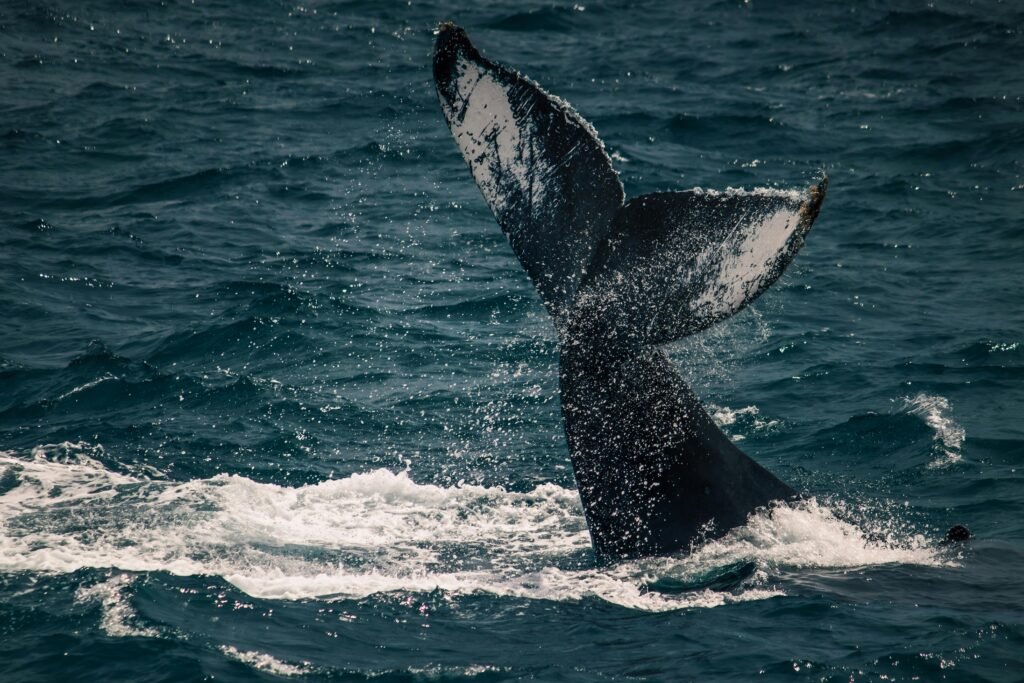
Image: Blue whale in Cabo San Lucas, Mexico
Where to Go:
- Yucatán Peninsula: Beaches, ruins, and some seriously good ceviche.
- Oaxaca: Culture central, with incredible Holy Week parades and street food galore.
- Mexico City: Less crowded than coastlines, but buzzing with art, food, and springtime festivals.
Pro Planning Tip:
If you’re traveling during Semana Santa, book everything early—like, “I-planned-this-in-January” early. Flights, hotels, even restaurant reservations can fill up fast.
GOHUB on the Go:
With crowds everywhere and events popping up, staying connected is clutch. A Gohub eSIM means:
- You won’t get lost in Oaxaca’s winding alleys
- You can check beach conditions in real-time
- And yes, you can upload that beach sunset before your friends back home go to bed
May: The Hidden Gem Between Seasons
If you love warm weather, great deals, and fewer people photobombing your shots of colonial churches, May is your month. It’s Mexico’s “in-between” season—hot? Yep. Humid? Starting to be. But also gloriously less crowded, more affordable, and still mostly rain-free.
What’s the Vibe?
- Weather: Hot and getting a little steamy (26–35°C / 79–95°F)—pack those breezy clothes and don’t fight the siesta urge.
- Crowds: Thinning out, which means shorter lines, more space, and easier bookings.
- Culture: While Cinco de Mayo isn’t a huge national thing, Puebla turns it into a full-blown historical celebration—with parades, costumes, and street food you’ll dream about.
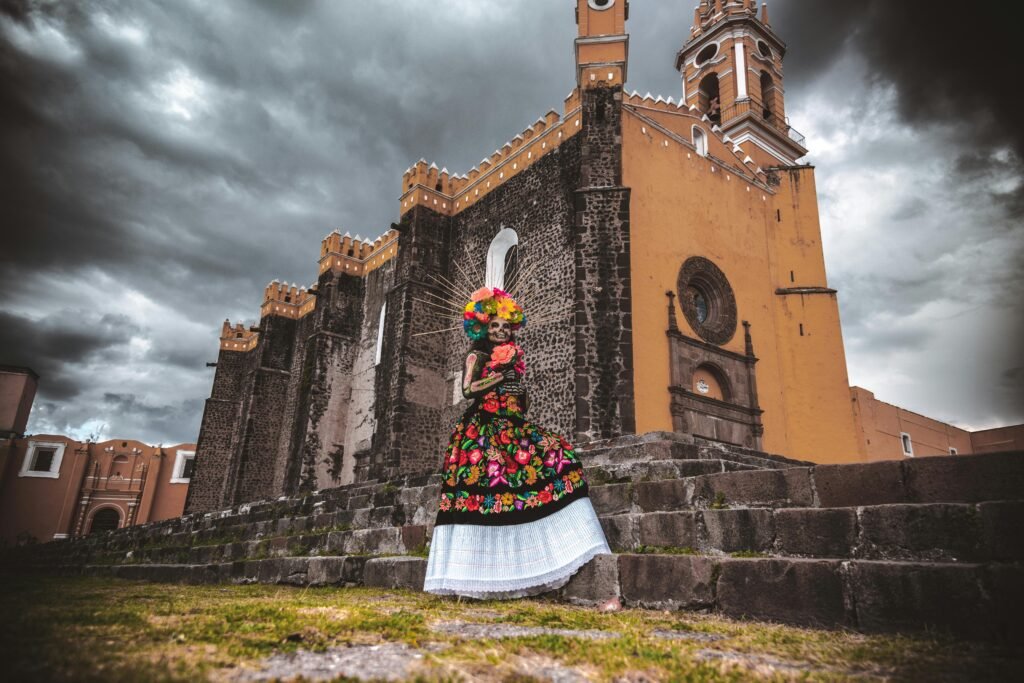
Image: A woman with face paint standing near a church
Where to Go:
- Mexico City: Cooler than the coasts, full of spring energy, and perfect for museum-hopping or roaming hipster neighborhoods.
- Guadalajara: Think mariachi, tequila, and zero Spring Breakers.
- San Miguel de Allende: Art, charm, and way more peace than peak season.
Budget Travel Tip:
May is one of Mexico’s best-kept secrets for savvy travelers—lower prices, shorter wait times, and no major weather disruptions yet. That means more tacos for your peso and more freedom to roam.
June–August: Rainy Days, Green Dreams & Turtles on the Beach
Welcome to Mexico’s summer vacation season—a time when the air is thick, the jungle is thriving, and baby sea turtles are making their big debut. From June to August, you’ll get hot, humid days, afternoon showers you can set your watch to, and some seriously low-key magic if you’re willing to embrace the elements.

Image: Baby sea turtle on the Beach
What to Expect:
- Weather: Expect a steamy 25–36°C (77–97°F) with regular afternoon downpours—usually brief but dramatic. It’s the tropics, baby.
- Crowds: Moderate, mostly domestic travelers (it’s summer break in Mexico too!).
- Nature: Lush landscapes, fewer tourists, and the unforgettable sight of sea turtles nesting along the coasts—pure magic.
Where to Go:
- Mexico City: Cooler and less rainy than the coasts—perfect for museums, food tours, and cozy rooftop bars.
- Riviera Maya: Yes, it’s humid—but the ocean breezes, cenotes, and turtle watching in Tulum make it so worth it.
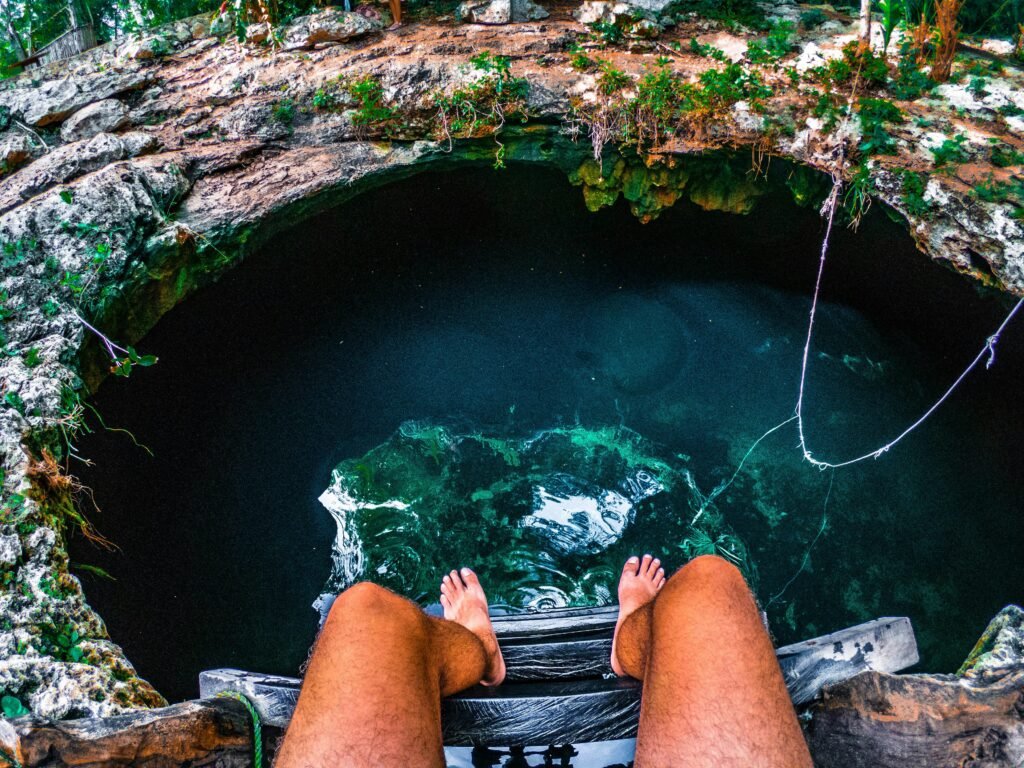
Image: View of underground water in Tulum
How to Travel Smart:
- Do your outdoor stuff early. Mornings are sunny and fresh, afternoons get splashy.
- Pack light, fast-drying clothes and don’t fear the rain—it’s usually short-lived and super refreshing.
- Bonus: Fewer crowds = better photos + more chill.
Seasonal Highlight:
Sea turtle nesting season peaks in July and August, especially along Quintana Roo’s beaches. Witnessing a mama turtle lay her eggs or hatchlings racing to the sea? It’s a core memory waiting to happen.
Stay Dry, Stay Connected
Rainy days are perfect for planning tomorrow’s adventure, catching up on travel journals, or calling home. And with your Gohub eSIM, you’ll stay connected even when:
- Your Airbnb Wi-Fi disappears mid-thunderstorm
- You’re Googling “best cenotes near Tulum” from a colectivo
- You need to book a last-minute indoor tour to dodge the rain

Image: Sea turtle nesting on a beach in summer.
September–October: Stormy Skies & Soulful Moments
If you’re cool with a little unpredictability and don’t mind packing an umbrella next to your curiosity, September and October offer a side of Mexico that most travelers miss. It’s humid, quiet, and deeply local—a time when the country slows down, the rain rolls in, and the real magic starts to stir.
The Forecast:
- Weather: Moist and moody with temps around 24–33°C (75–91°F). Expect regular downpours, especially along the coast.
- Crowds: What crowds? You’ll have museums, plazas, and even popular towns practically to yourself.
- Vibe: Rainy afternoons + warm hospitality = perfect conditions for slow travel and meaningful cultural moments.
Why It’s Still Worth It:
- September 16 – Mexico’s Independence Day: Think fireworks, live music, parades, and a whole lotta pozole
- Day of the Dead prep: By late October, towns like Oaxaca and Pátzcuaro begin setting up for Día de los Muertos with altars, marigolds, and candlelit vibes that are just chef’s kiss.
Where to Go:
- Central Highlands: Cooler, less affected by hurricanes, and bursting with culture.
- Mexico City: Tons to explore indoors + lots of pre–Day of the Dead energy.
- Guadalajara: Fewer crowds, authentic food, and mariachi soul.
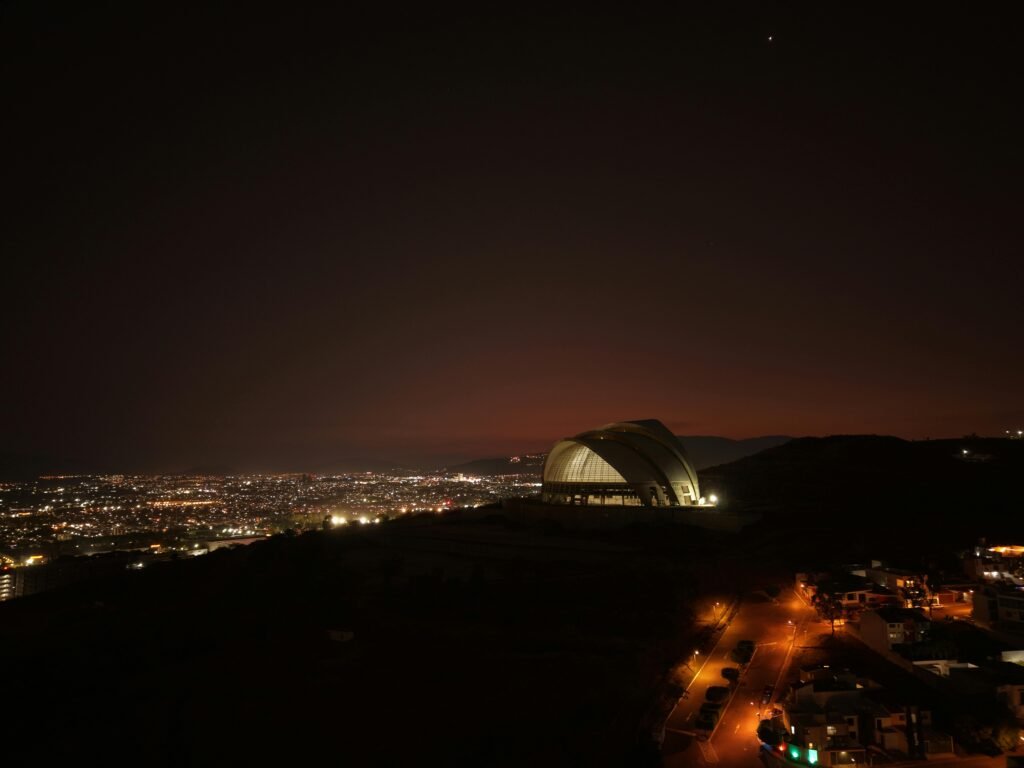
Image: Nighttime View of Guadalajara Cityscape
Travel Smart:
- Hurricane season peaks now, especially in coastal areas like Cancun, Riviera Maya, and Pacific hotspots. Stay updated via weather apps, have a flexible plan, and travel inland if you’re unsure.
Budget Bonus:
This is extreme budget travel season—flights, hotels, and tours are at their lowest prices of the year. If you’re game for a little rain, you’ll save big and see a more authentic, local side of Mexico.
November: Cultural Gold in the Calm Before High Season
November in Mexico feels like a quiet exhale before the holiday rush. The rains ease up, the air cools, and the vibrant traditions of Día de los Muertos light up streets, cemeteries, and hearts. It’s Mexico at its most soulful—and possibly, most beautiful.
Weather & Vibes:
- Temperatures: A comfortable 23–30°C (73–86°F)—just right for long walks through flower-filled markets or evening strolls under papel picado.
- Rainfall: On its way out, along with the stickiness of hurricane season.
- Crowds: Growing, but still manageable—think curious travelers, not tour bus armies.
Why Go Now?
- Día de los Muertos (Nov 1–2): One of Mexico’s most iconic and heartfelt celebrations. Think marigold paths, candlelit altars, face painting, music, family feasts, and spiritual beauty that gives you goosebumps.
- Cultural immersion: November is a portal into authentic Mexican life. Locals open their homes, their rituals, and their stories—if you’re respectful, you’re welcome.
Where to Go:
- Oaxaca: The capital of Day of the Dead magic—parades, markets, and midnight cemetery visits under a sky full of stars.
- Mexico City: Home to both massive parades and intimate neighborhood altars.
- Michoacán (especially Pátzcuaro): Deeply spiritual and atmospheric—less flashy, more heart.

Image: Yellow butterflies Flying in Sunlight
Best For:
Moderate crowds mean freedom to explore, snap beautiful shots, and soak up real moments—no filter needed.
Culture lovers, photographers, and travelers who want depth over hype.

Image: Día de los Muertos
December: Sun, Sand & Holiday Sparkle
While snowflakes fall elsewhere, Mexico’s wrapping itself in sunshine and string lights. December is a holiday dream come true—think perfect beach weather, posadas in the plazas, and Christmas piñatas instead of parkas.
It’s festive, it’s vibrant, and yeah—it’s crowded. But if you plan ahead, you’ll land right in the middle of the magic.
What to Expect:
- Weather: Dry, sunny, and blissfully mild—22–29°C (72–84°F). Whether you’re chilling on the coast or café-hopping in the highlands, it’s all pleasant.
- Crowds: Very high, especially around Christmas and New Year’s. Everyone from international travelers to local families is out and about.
- Vibe: Joyful chaos in the best way—colorful, musical, and full of heart.
Why You’ll Love It:
- Christmas in Mexico means posadas (traditional processions), piñatas, fireworks, tamales, and late-night celebrations that stretch to dawn.
- Festive decorations are everywhere—city squares turn into glowing wonderlands.
- Beach weather? Oh yes. It’s warm, sunny, and perfect for ringing in the New Year with your toes in the sand.
Where to Go:
- Everywhere’s good—but the beaches book out first.
- Tulum, Playa del Carmen, Sayulita: Sun + sand + salsa.
- Mexico City & Oaxaca: Culture, food, and twinkly lights galore.

Image: View of tropical beach in Playa del Carmen
Booking Tip:
This is the month to book the earliest. Flights, hotels, even dinner reservations get snapped up months ahead—especially for the last two weeks. Don’t wing it.
IV. Regional Guide: When to Visit Different Parts of Mexico
From sun-drenched beaches to misty highlands, Mexico’s regions don’t just look different—they feel different, season by season. So if you’re wondering “Where should I go, and when?”—you’re in the right place.
We’ll start with one of the most iconic regions: the Yucatán Peninsula—where Mayan ruins, cenotes, and coastlines collide in the best way possible.
Best Time to Visit the Yucatán Peninsula: Sun, Cenotes & Serpent Shadows
The Yucatán Peninsula is where ancient ruins meet turquoise beaches, tacos meet jungle, and the Wi-Fi’s strong enough (if you’re on Gohub 😎) to send jealous snaps from a hammock in Tulum. But not all months are created equal down here—weather, crowds, and vibes shift dramatically throughout the year.
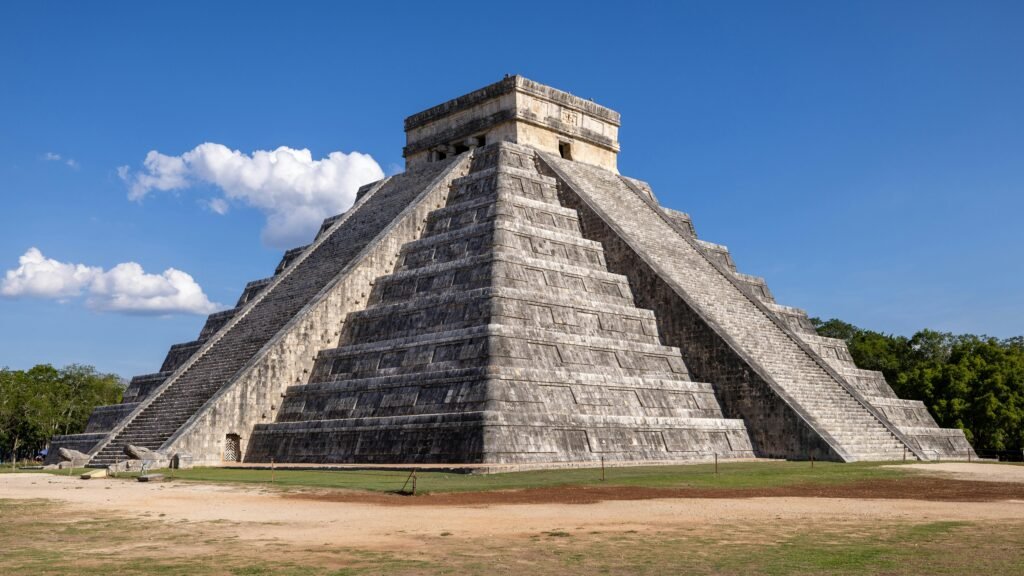
Image: El Castillo, Chichen Itza, Yucatan, Mexico
Here’s how to time your trip like a pro:
Peak Season (December–April): Beach Weather Bliss
This is the golden stretch—clear skies, calm seas, and the kind of 28–30°C (82–86°F) temps that make you say, “Why do I even own winter clothes?”
- Pros: Dry days, postcard-perfect beaches, best swimming & diving conditions
- Cons: It’s popular—expect higher prices and booked-out beach clubs
- Perfect for: Sunseekers, honeymooners, digital nomads escaping winter
GOHUB Tip: Explore cenotes in the early morning when they’re cool, quiet, and mystical AF. Oh, and don’t forget to book Chichén Itzá early—this season draws the crowds.
Shoulder Season (May & November): Balance & Bargains
Want fewer tourists without sacrificing your tan? These in-between months are your sweet spot.
- Weather: Warm and humid, with occasional showers—but usually short-lived
- Crowds: Lighter than peak season = better rates, more relaxed vibes
- Perfect for: Budget-savvy travelers, culture lovers, off-peak adventurers
Don’t Miss: The equinox events (around March 21 & Sept 22) at El Castillo in Chichén Itzá—watch the serpent-shaped shadow slither down the pyramid like ancient magic. Seriously goosebumps-worthy.
Low Season (June–October): Lush, Wet & Wild
This is rainy season and yes, it’s hot, humid, and storm-prone—but also wildly underrated for travelers who want a more local, lush, and less touristy vibe.
- Weather: Daily afternoon showers, especially July–September
- Hurricane risk: Highest in August–October—watch the forecasts
- Pros: Greenest landscapes, sea turtle nesting season, deep discounts
- Perfect for: Flexible travelers, photographers, jungle explorers
GOHUB Reminder: If you’re visiting during this season, a Gohub eSIM is essential. Stay updated on weather alerts, rebook on the go, and navigate like a local—even when the rain’s pouring and Google Maps is your best friend.
Best Time to Visit Mexico City & The Central Highlands: Eternal Spring & Cultural Gold
If you’re dreaming of cobblestone streets, cool cafés, and endless culture, Mexico City and the central highlands (think San Miguel de Allende, Puebla, Guanajuato) are your go-to. Perched high above sea level, this region offers a mild, spring-like climate year-round—plus a rich tapestry of festivals, food, and colonial charm.
Here’s how the seasons break down so you can time your trip just right:
November–April: The Dry Season Sweet Spot
- Weather: Dry, sunny, and oh-so-pleasant—think 22–27°C (72–81°F) by day
- Crowds: Just right; not too overwhelming
- Perfect for: Rooftop brunches, museum marathons, day trips to Teotihuacán
Local Vibe: These months offer clear skies and crisp air—ideal for wandering art-filled neighborhoods like Coyoacán or biking down Reforma on a Sunday morning.
May–October: Afternoon Showers & Fresher Air
- Weather: Still warm, but afternoon showers roll in—great for siesta time
- Perks: Cooler than the coasts, and the rains clear out pollution, making air quality noticeably better
- Perfect for: Café hopping, indoor markets, cultural festivals (like Grito de Dolores in September)
Pro Tip: Don’t let the “rainy season” scare you—it rarely rains all day. Pack a light jacket and plan your outdoor stuff before 3 PM. You’ll be golden.
December–January: Crisp Mornings, Cozy Vibes
- Weather: Days are still pleasant, but nights drop to 10–12°C (50–54°F)—bring that extra layer!
- Perfect for: Holiday lights, tamales, and warm drinks in candlelit courtyards
Chill Bonus: The cooler temps give the highlands a cozy, romantic feel—especially around Christmastime in places like San Miguel de Allende.

Image: Mexico City skyline with clear blue skies.
Best Time to Visit Mexico’s Pacific Coast: Sun, Surf & Slow Vibes
From golden beaches and dramatic cliffs to fish tacos at sunset, Mexico’s Pacific Coast is a vibe all its own. Whether you’re chasing surf breaks or just that do-nothing-and-love-it beach mood, timing matters—especially with the region’s split personality between dry and wet seasons.
So when should you go? Depends on what you’re after: sunshine, savings, or sweet waves.
November–May: Dry Season = Beach Bliss
- Weather: Warm, sunny, and reliably gorgeous—expect 29–33°C (84–91°F)
- Rain? What rain? You’ll barely see a drop.
- Perfect for: Sunbathing, boat tours, whale watching, sipping piña coladas like you mean it
Top spots: Puerto Vallarta for all-around beach town charm, Huatulco for laid-back luxury, Acapulco if you’re feeling retro-glam.
June–October: Tropical Rains & Surfer Highs
- Weather: Hot and humid with intense afternoon rains—especially August–September
- Pros: Lush landscapes, fewer crowds, and amazing surf
- Perfect for: Early morning beach walks, surfing sessions, low-season deals
Surf’s Up Tip: The best swells hit from May to November, especially along Oaxaca’s coast.
Don’t Miss: Puerto Escondido—Mexico’s surf mecca. Even during rainy season, the mornings are perfect, and the waves? Chef’s kiss. Just plan your siestas when the skies open up.

Image: Puerto Escondido, Mexico
Best Time to Visit Baja California: Whales, Waves & Wine Country Vibes
Baja California is where desert meets the sea and wildlife meets wow-factor. From the turquoise bays of La Paz to the luxe resorts of Los Cabos, this stretch of Mexico’s northwest coast is full of surprises, serenity, and some of the best whale watching on Earth.
Planning your trip right means syncing with both nature and the seasons. Here’s how to catch Baja at its very best:
January–March: Whale Watching Wonderland
- Why go now: It’s peak season for spotting gray, humpback, and even blue whales as they migrate and calve in the warm Pacific waters.
- Where to go: Head to Magdalena Bay or Laguna San Ignacio for up-close encounters—like, boat-side eye contact kind of close.
- Weather: Cooler mornings, sunny afternoons, and stunning visibility
Nature-Lover Tip: Baja is one of the only places on Earth where gray whales approach boats voluntarily. It’s not a tour—it’s a soul-shaking connection.
April–June: Dry, Quiet & Gloriously Chill
- Weather: Little to no rain, rising temps (mid-20s to low 30s°C / 77–91°F)
- Vibe: Fewer tourists, calm seas, ideal for kayaking, paddleboarding, and wine tasting
- Perfect for: Beach lounging, diving in the Sea of Cortez, road-tripping along the scenic coast
GOHUB Suggests: This is also a great time to explore Valle de Guadalupe—Mexico’s up-and-coming wine country, just a couple hours from the U.S. border.
August–October: Storm Season (But Still Gorgeous)
- Weather: Hot and humid, with occasional tropical storms
- Hurricane risk: Present, but generally lower than Mexico’s Caribbean side
- Pros: Low crowds, dramatic skies, and lush desert blooms if you’re lucky
Stay Flexible: This is when having a Gohub eSIM pays off—check weather updates on the fly, reroute road trips if needed, or find that cozy Baja casita to hole up in during a rainstorm.
V. Festival-Based Travel Planning: Follow the Fiesta, Find the Soul
Sure, Mexico’s got jaw-dropping beaches and ancient ruins—but if you really want to feel the heart of this country, plan your trip around a local festival. These moments are when culture, tradition, and community come alive—with music in the streets, altars in the plazas, and tacos that taste better under fireworks.
Let’s start with the most soul-stirring celebration of all…
Day of the Dead (Nov 1–2): Beauty, Memory & Marigolds
Forget spooky costumes—Día de los Muertos is something much deeper. It’s a celebration of life, love, and those who came before us. Streets glow with candlelit altars, families gather to share stories, and marigolds line the way for spirits returning home.
Best Places to Experience Day of the Death:
- Oaxaca City – The ultimate cultural hub, with parades, markets, and late-night cemetery visits
- Pátzcuaro – Mystical and intimate, where lakeside candlelight reflects ancestral magic
- Mexico City – Home to massive parades and artistic altars in public spaces
- San Miguel de Allende – A beautiful blend of tradition and elegance, with face painting, music, and colorful décor everywhere
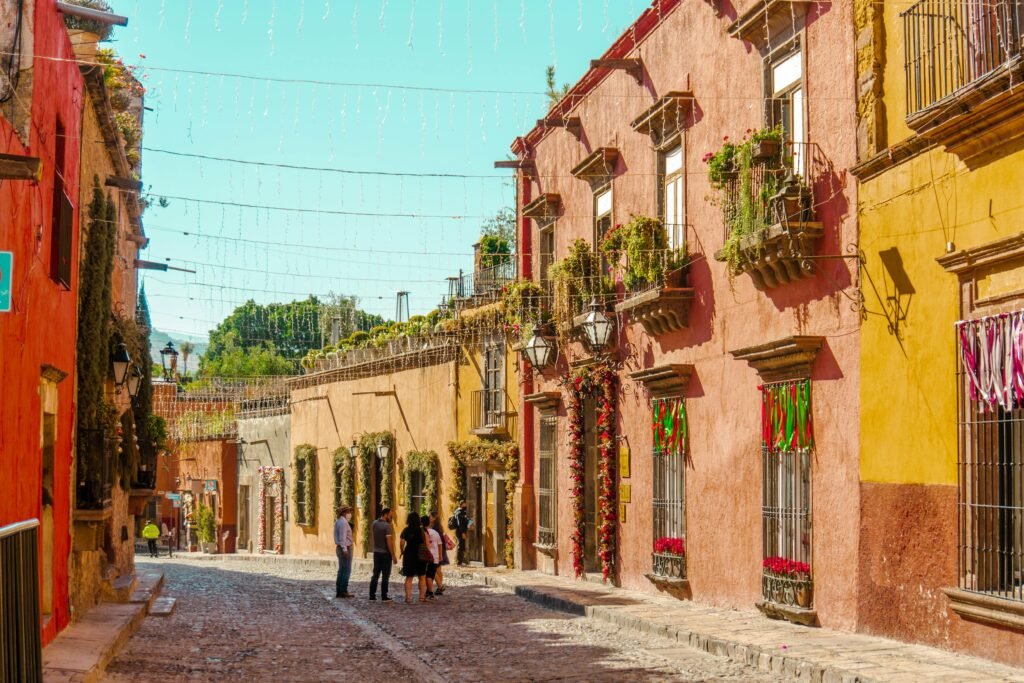
Image: Colorful street in San Miguel de Allende
Planning Tip:
This is one of Mexico’s busiest cultural weeks—book accommodations 3–6 months in advance, especially in Oaxaca or Pátzcuaro. Last-minute options disappear fast.
Weather Watch:
Early November brings mild, pleasant weather (23–30°C / 73–86°F) and decreasing rainfall—perfect for nighttime parades and long cemetery vigils.
Cultural Immersion Tip:
Want more than just cool photos? Join a guided tour led by locals to understand the spiritual symbolism, indigenous roots, and modern expressions of this sacred celebration. It’s not just beautiful—it’s profoundly moving.
Holy Week (Semana Santa, March–April): Spiritual Processions & Cultural Devotion
If you’re drawn to travel that touches both the soul and the senses, plan your visit during Semana Santa—Mexico’s Holy Week, a powerful fusion of religion, community, and visual storytelling. This isn’t just a holiday; it’s a national heartbeat.
From candlelit processions to dramatic reenactments of the Passion, the entire country comes alive with faith, tradition, and an unforgettable atmosphere.
Best Places to Witness Semana Santa
- San Miguel de Allende – A graceful blend of tradition and pageantry with flower-strewn streets and moving processions through cobblestone alleys
- Taxco – Known for its intensely emotional processions, with participants walking barefoot and hooded in centuries-old ritual
- San Cristóbal de las Casas – Indigenous customs meet Catholic tradition in the highlands of Chiapas—raw, powerful, and profoundly local
Planning Note:
Semana Santa typically falls in late March or early April, right in the heart of the dry season—so weather is usually perfect for outdoor events. But be warned: this is also one of Mexico’s busiest domestic travel periods.
Accommodations and transportation fill up fast. If you’re eyeing a popular town, book at least 3 months in advance—seriously.
Want a More Authentic Experience?
Skip the mega-touristy cities and head to smaller towns, where Holy Week feels intimate, deeply spiritual, and less commercialized. You’ll be welcomed into candlelit chapels, silent processions, and traditions passed down for generations.tions.
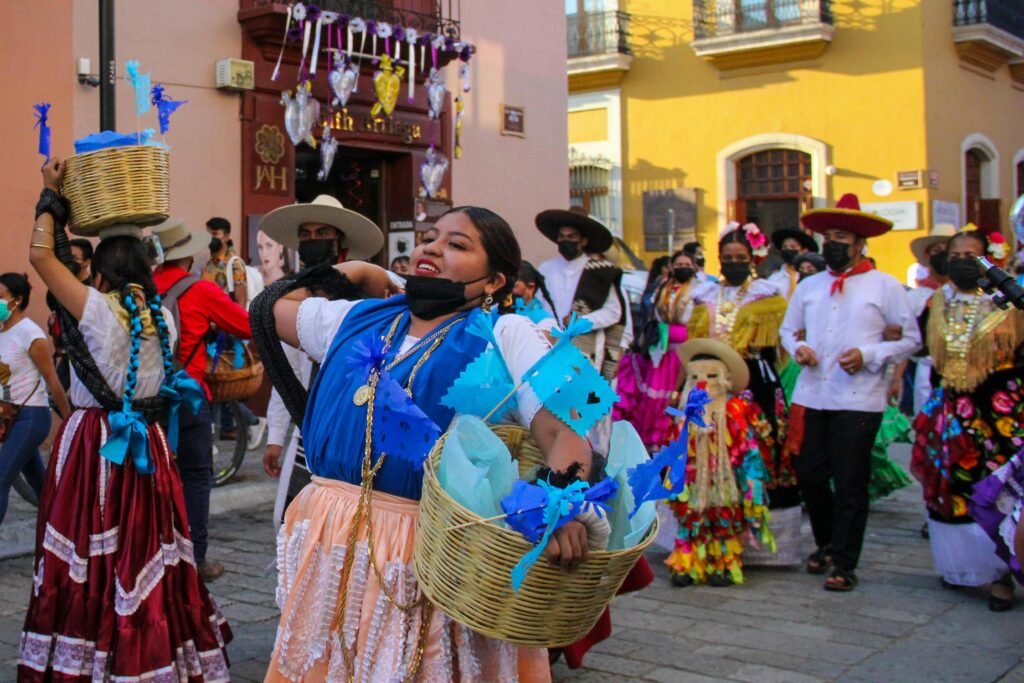
Image: Colorful Day of the Dead celebration in Oaxaca
Independence Day (September 16): Viva México in Full Color
If you want to feel the soul of Mexico roar to life, Independence Day is the time to go. Taking place on September 16, this national holiday turns entire cities into a patriotic party zone, complete with fireworks, street food, mariachi, and the iconic “Grito de Dolores”—a rallying cry that still gives goosebumps.
It’s more than a celebration. It’s a nationwide moment of pride, passion, and pure fiesta energy.
Best Places to Celebrate
- Mexico City (Zócalo): The heart of the action, where hundreds of thousands gather in the main square to hear the President shout the grito from the National Palace
- Dolores Hidalgo: The very birthplace of the independence movement—authentic, historic, and deeply moving
- Guadalajara: Mariachi capital meets patriotism, with huge parades and outdoor concerts
What to Expect:
- The real party starts the night of September 15—with fireworks, parades, concerts, and the iconic presidential reenactment of the independence cry
- September 16 is a national holiday, with continued festivities and military parades across the country
Pro Tip: Don’t miss the crowd chanting “¡Viva México!” in unison—it’s one of those once-in-a-lifetime travel moments that sticks with you forever.
Weather Watch:
Yes, it’s the rainy season—but don’t stress. The skies usually cooperate enough for nighttime events to go ahead. Just bring a light rain jacket, and maybe an umbrella that doubles as a parade prop.
Planning Tip:
If you’re heading to Mexico City’s Zócalo, book accommodations months in advance—hotels with balcony views of the square go fast. Same for Dolores Hidalgo, which transforms into a historic festival town overnight.
VI. Activity-Based Timing for Your Mexico Trip
Mexico isn’t just a place to visit—it’s a place to do. Whether you’re hoping to watch whales breach, trek through canyons, or dive into sapphire cenotes, timing makes all the difference.
Here’s how to plan your trip based on your favorite adventures:
Wildlife Viewing Seasons: Nature’s Big Moments
If you’re the kind of traveler who’d rather spot a whale than hit a rooftop bar, Mexico’s wildlife calendar is calling your name.
Whale Watching (Jan–Mar)
Head to Baja California for front-row seats to the gray, humpback, and even blue whale migration.
Top spots: Magdalena Bay, Guerrero Negro, La Paz
Butterfly Migration (Jan–Feb)
Millions of monarchs blanket the trees at the Monarch Butterfly Biosphere Reserve in Michoacán. It’s like a living, fluttering fairytale.
Base yourself in: Angangueo or Zitácuaro
Sea Turtle Nesting (Jun–Nov)
Both the Pacific and Caribbean coasts play host to mama turtles laying eggs—and baby turtles making their mad dash to the sea.
Where to watch: Puerto Escondido, Tulum, Mazunte
Flamingo Watching (Dec–Apr)
Thousands of flamingos flock to Celestún and Río Lagartos in Yucatán. Pink, peaceful, and perfect for bird lovers.
Tip: Go early in the day when light is best for photos.
Photographer’s Dream: January and February are the only months where you can catch whales AND monarchs—the double-whammy of bucket-list wildlife experiences.
Beach & Water Activities: Salt, Swells & Cenote Swims
Whether you’re floating in turquoise water or chasing the perfect wave, here’s when the sea plays nice:
Best Swimming Conditions (Dec–Apr)
Calm seas + warm temps = perfect for casual dips and lazy beach days.
Surfing (May–Nov)
Bigger, better swells roll into the Pacific Coast, especially Puerto Escondido, Sayulita, and Baja’s Pacific side.
Diving Visibility (Feb–May)
Crystal-clear views before the rainy season hits—perfect for spotting reef sharks, rays, and vibrant coral.
Snorkeling (Mar–Jun)
Cenotes and reef systems shine during these months, with warm water and clear visibility.
Water Sports Sweet Spot: April and May = warm waters, top-notch visibility, fewer crowds. Ideal for diving or snorkeling in Cozumel or Akumal.

Image: Diving in the Yucatán
Hiking & Outdoor Adventures: Mountains, Canyons & Desert Cool
Ready to lace up your boots and go off-grid? These are the months when Mexico’s natural playgrounds are at their best.
Copper Canyon (Oct–Nov, Mar–Apr)
Sweeping views, deep ravines, and perfect temps for full-day hikes or scenic rail rides.
Volcano Climbing (Nov–Feb)
Cooler weather = better stamina for summiting Iztaccíhuatl, Nevado de Toluca, or even the big boy Pico de Orizaba.
Jungle Trekking (Dec–Apr)
Less rain, fewer bugs—yes please. Great for Chiapas or southern Yucatán treks.
Desert Exploration (Nov–Mar)
Head north to Baja’s desert or Chihuahua for hikes, stargazing, and sunsets that slap without the heatstroke risk.
Outdoor Enthusiast Tip: The winter months are your best bet for staying cool, dry, and bug-bite-free on the trail.
VII. Practical Travel Tips for Any Season in Mexico
Whether you’re chasing cenotes in Tulum, hiking volcanoes in Puebla, or devouring tacos in Oaxaca, a little preparation goes a long way. These season-proof travel tips will help you stay connected, comfortable, and confident—rain or shine, coast or canyon.
Staying Connected Across Mexico
Staying online in Mexico isn’t just about uploading your beach shots (though yes, that too 😍)—it’s about navigation, weather alerts, booking apps, translations, and safety.
Here’s how to keep that signal strong:
- Local SIM cards – Available at airports, convenience stores, and carrier kiosks. Good for longer stays, but may require ID and setup time.
- eSIM solutions (like Gohub 😉) – Activate before you land for instant, hassle-free connectivity. No swapping SIMs. No roaming fees. Just go.
- Download offline maps – Use Google Maps offline for regions with patchy coverage or no service (especially in remote jungle or mountain towns).
- Weather apps – Rainy season = unpredictable. Apps like Windy, AccuWeather, or MeteoRed help you stay a step ahead.
Rainy Season Pro Tip: Wi-Fi in some hotels can drop during intense storms. Having a Gohub eSIM as your backup ensures you can still message, rebook, or reroute on the fly.
What to Pack: Dry vs. Rainy Season
Your suitcase should work as smart as you do. Here’s what to bring, depending on the season:
Dry Season (Nov–Apr)
- Lightweight, breathable clothes (linen & cotton = besties)
- High-SPF sunscreen (yes, even if it’s cloudy!)
- Wide-brimmed hat & sunglasses
- Reusable water bottle (hydration is life)
- Light sweater or jacket – especially in Mexico City or mountain towns
Rainy Season (May–Oct)
- Quick-dry clothes – no one likes squishy jeans
- Sturdy rain jacket or poncho – fashion meets function
- Waterproof phone case – protect your precious maps & photos
- Insect repellent with DEET – mosquitos love humidity
- Dry bag or waterproof pouch for electronics (especially on boats or hikes)
✈️ Landing in CDMX? Here’s how to get a SIM card at Mexico City airport.
VIII. Health & Safety Essentials: Travel Smart, Wander Freely
Being prepared isn’t about being paranoid—it’s about traveling smart so you can enjoy every second of your Mexico adventure without surprises (well, except the good kind—like finding a street taco stand at midnight).
Here’s your GOHUB-approved checklist for staying healthy, safe, and totally in the moment:
Hurricane Season Prep (June–November)
Mexico’s coastlines are stunning—but if you’re visiting during storm season, make sure you:
- Know your hotel’s evacuation plan
- Stay updated with reliable weather apps
- Pack a Gohub eSIM so you don’t lose connectivity if Wi-Fi goes down
- Consider travel insurance with weather-related coverage just in case plans need to pivot
Sun Protection Year-Round
The tropical sun does not mess around—even in December, you can get scorched faster than you can say “one more margarita.”
- Use high-SPF sunscreen daily (reapply often!)
- Bring a hat and sunglasses
- Lightweight, long-sleeve clothing = your skin’s new BFF
Hydration Matters
Between the sunshine, heat, spicy food, and margaritas—hydration can sneak up on you.
- Always drink bottled or purified water
- Skip tap water, including ice unless you’re 100% sure it’s filtered
- Bring electrolyte tablets or packets, especially if you’ll be hiking, surfing, or sweating it out in the jungle
Mosquito Defense
Those tiny ninjas come out strongest during the wet season and in jungle or coastal zones.
- Use repellent with DEET or picaridin
- Wear light long sleeves in the evenings
- Stay in accommodations with mosquito nets or sealed windows
Food Safety 101
Your taste buds want adventure—but your stomach wants a little common sense.
- Stick to busy food stalls or restaurants = fast turnover = fresher food
- Say yes to tacos, but maybe pause on that mystery seafood buffet sitting in the sun
- Keep hand sanitizer with you (just in case)
Travel Insurance: Non-Negotiable
Even the best-planned trips can hit a bump—whether it’s a missed connection, a hiking injury, or a tropical storm surprise.
- Look for policies that cover medical emergencies, hospital stays, and weather-related disruptions
- Pro tip: Some policies also reimburse delayed baggage, so you’re not buying overpriced swim trunks at the airport
IX. Budget Considerations: Balancing Cost and Experience
Let’s be real: your budget shapes your adventure. But the good news? Mexico offers incredible travel experiences year-round, and with the right timing, you can save big without sacrificing fun.
Here’s how the seasons stack up, cost-wise:
High Season (December–April): Perfect Weather, Premium Price
This is Mexico’s “everybody-wants-in” season—especially over the holidays and spring break. Sunshine? Guaranteed. Prices? Spicy.
- Accommodation: Expect 30–50% higher than low season rates
- Activities: Tours book out fast & cost more, especially in beach destinations
- Flights: Peak pricing, especially from the US, Canada, and Europe
- Best For: Travelers who want perfect weather and don’t mind paying a bit more for it
Shoulder Season (May & November): The Sweet Spot
Ahhh, the golden middle—a perfect blend of good weather and good value. Fewer tourists, better deals, and still plenty of sunshine.
- Accommodation: Moderate rates, often with promo deals
- Activities: Regular pricing, but with better availability
- Flights: More affordable, though fewer direct routes in some cases
- Best For: Budget-conscious travelers who still want amazing conditions and fewer crowds
Budget Tip: May and November are the best-value months in Mexico. Great weather, great prices, and you’ll have cenotes and colonial streets almost to yourself.
Low Season (June–October): Storm Clouds, Steep Savings
It’s hot, it’s wet, and it’s ridiculously affordable. This is your season if you love lush landscapes, quiet towns, and deep discounts.
- Accommodation: Lowest rates of the year, including deals at luxury resorts
- Activities: Bargain prices, and yes—you can often negotiate
- Flights: Cheapest fares and flexible booking options
- Best For: Flexible travelers, slow travelers, digital nomads, and those who don’t mind a little afternoon rain
Pro Tip: Early mornings are golden for exploring before the rain hits. Bring a light poncho, and let the storms bring the crowds down—and the magic up.
X. Conclusion: Finding Your Perfect Time to Visit Mexico
The best time to visit Mexico ultimately depends on your priorities:
- For perfect weather and maximum activities: December to April
- For ideal balance of good weather and fewer crowds: May, November
- For budget travel and lowest prices: June to October
- For cultural festivals: Plan around specific events like Day of the Dead (November) or Independence Day (September)
- For wildlife encounters: January to March for whale watching and butterfly migrations
Mexico’s magic isn’t confined to a specific season—each period offers its own unique charm and advantages. Whether you’re seeking sun-drenched beach days, cultural immersion, or budget-friendly luxury, there’s a perfect time for your Mexican adventure.
Remember that flexibility is key to enjoying Mexico in any season. Embrace the country’s rhythm, adjust your plans according to weather conditions, and you’ll discover why Mexico remains one of the world’s most beloved destinations regardless of when you visit.
Ready to plan your Mexico adventure? Explore our guides on where to stay in Mexico, top activities for every season, and how to stay connected during your trip!
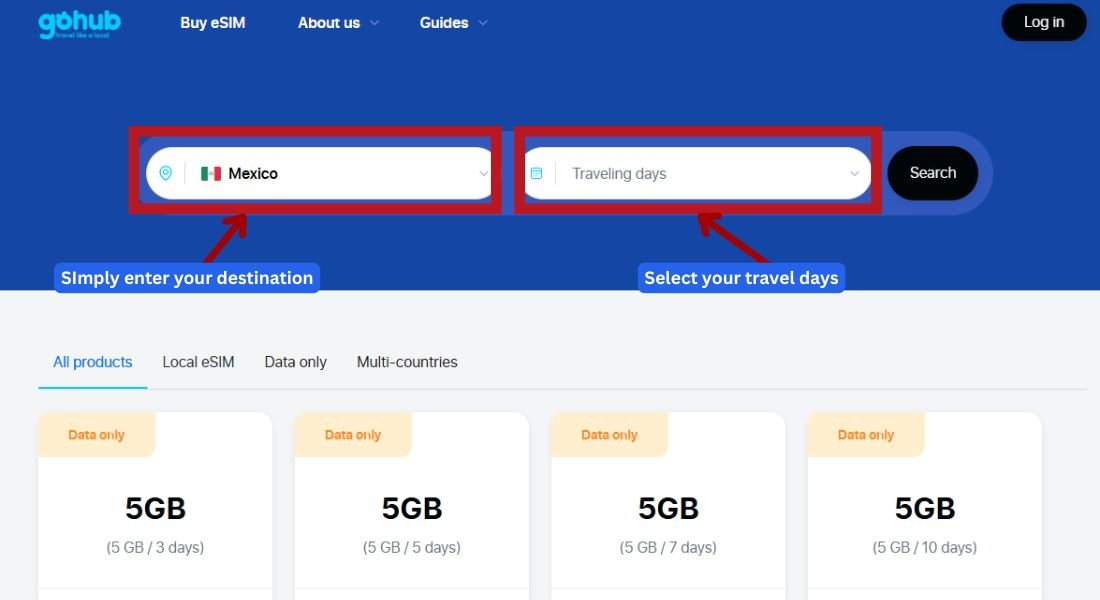
Image: Screenshot of the GoHub eSIM webpage, highlighting the destination input field with “Mexico” selected, illustrating how users can easily search for eSIM data plans.
📶 From beach towns to bustling cities, stay connected across Mexico with a Gohub eSIM. No roaming fees, no SIM card hassle—just pura vida!


